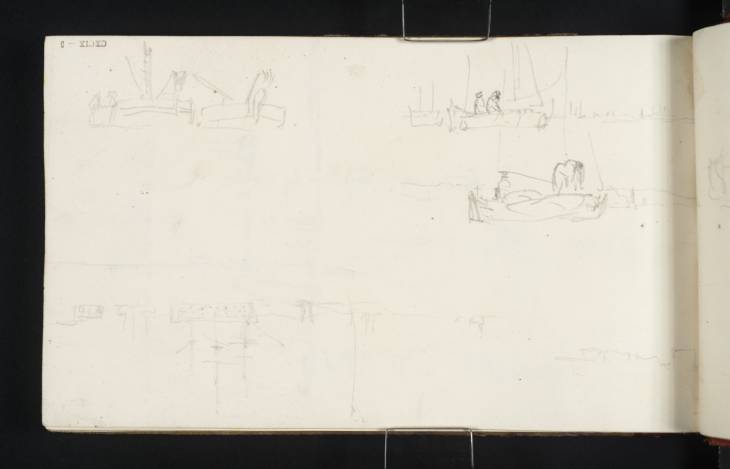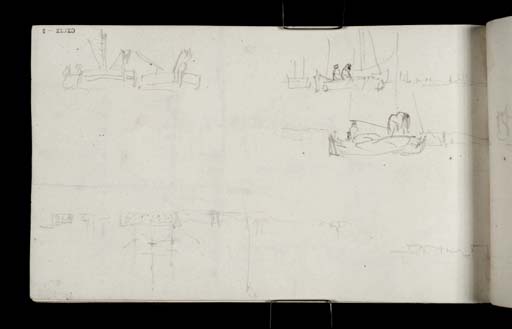Joseph Mallord William Turner Groups of Ships c.1821
Image 1 of 2
Joseph Mallord William Turner,
Groups of Ships
c.1821
Joseph Mallord William Turner 1775–1851
Folio 5 Recto:
Groups of Ships c.1821
D17373
Turner Bequest CXCIX 5
Turner Bequest CXCIX 5
Pencil on white wove paper, 112 x 190 mm
Partial watermark ‘R Bar | 18’
Stamped in black ‘CXCIX – 5’ top left, upside down
Partial watermark ‘R Bar | 18’
Stamped in black ‘CXCIX – 5’ top left, upside down
Accepted by the nation as part of the Turner Bequest 1856
References
1909
A.J. Finberg, A Complete Inventory of the Drawings of the Turner Bequest, London 1909, vol.I, p.607, CXCIX 5, as ‘Do.’ i.e. ‘Groups of ships’.
As identified by Finberg, who named each page identically, this sheet of drawings is coherent with the facing page on folio 4 verso (D17372), with which it overlaps both literally and thematically. It seems likely, therefore, that these studies originate from the same bout of sketching, a fact reinforced by their mutual composition upside down according to the foliation of the book.
However, three of the drawings on the present sheet are markedly more detailed and have been rendered with the application of more pressure to the pencil than the rest of the sketches on this and the facing page. At top left, a neatly composed study of unmanned shipping is the first example of this. At top right, two equally sure-handed sketches are stacked one on top of the other. The topmost example observes a pair of fishermen readying themselves to cast out onto the river beyond, the figure on the right stooping to attend to some necessary duty. Behind them are a number of docked boats. In the distance, at far right, the thriving waterway that awaits them is expressed by Turner through a combination of gestural, flat lines for the topography of the river bank, and vertical dashes describing masts which puncture the horizon.
Immediately beneath this drawing, indeed overlapping it, is the third example of a study handled with notable pressure and elaboration. Again, a sailing boat is the focus, and its large sail projects upwards into the sky, intersecting with the sketch above. The form of the vessel itself is more fluid, less rigid, than other examples on this page. Nonetheless, it seems to describe a fishing boat, occupied by another pair of figures. The presence of these figures is a tentative suggestion, but seems qualified by the two peaks in the rounded form towards the right; situated inside the vessel. Further back, in the distance, the river bank is visible, characterised by a gently ascending hillside beyond the water’s edge. Docked vessels or perhaps riverside buildings can be made out at far right.
The final drawing composed upside-down is situated in the top left corner. It describes two foreshortened fishing vessels moored immediately in front of a harbour building, distinguished by the sloping faces of its roof.
Turner also used this page oriented as per the foliation of the sketchbook. In this manner he produced a sketch at top right, which describes a ship of the line with three vertical masts, and two rows of windows lined up along the hull. This vessel is situated within the context of another river scene, which shows four additional boats, two on either side, and promotes the impression of thriving industry. In the background the undulating landscape of the surrounding topography is also similarly evident. A vertical line towards the centre of the sheet, and a horizontal marking beneath this drawing, seem to demonstrate Turner’s intention to mark this sketch off from the rest of the page, however he transgresses the vertical boundary and extends the drawing outside of these remits.
Maud Whatley
January 2016
How to cite
Maud Whatley, ‘Groups of Ships c.1821 by Joseph Mallord William Turner’, catalogue entry, January 2016, in David Blayney Brown (ed.), J.M.W. Turner: Sketchbooks, Drawings and Watercolours, Tate Research Publication, February 2017, https://www


